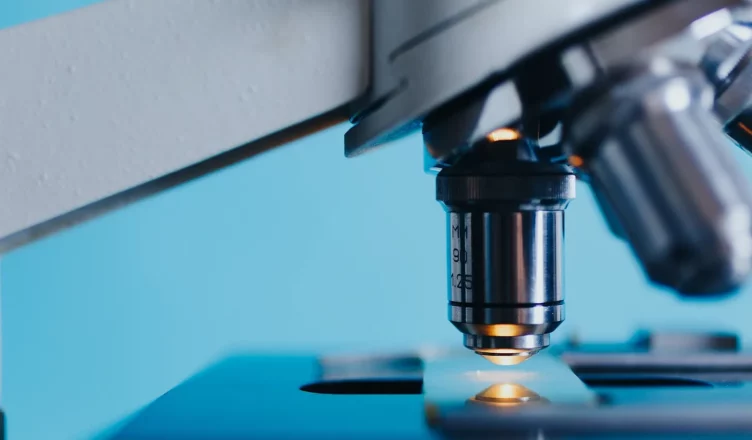The Stake In The Heart For This Pseudoscientific Profession
Introduction
One never realize how big the task of writing on a subject is until you start. One thing you can be assured of is how much you learn by writing about your findings or thoughts. My stance on virology has been clarified in two previous posts as follows:
Another thing you quickly realize on this journey is how easy it is to censor someone, especially if you start hitting a nerve. I have documented some of it underneath the conclusion of the The Gatekeepers Club article. It is very important to make copies of your work, as shadow banning is one thing, but if these platforms decide to terminate your channel and all the work you have done is on it, you will obviously lose it all. We were in that same position about a year ago when Discord decided to terminate our channel. Twenty of the smartest people you would ever know had been working on it for close to two years, and it was gone overnight. Therefore, this post will serve as safekeeping for some of the best information that I have come across in the last few weeks proving that virology is pseudoscience.
Thanks for reading dpl’s Newsletter! Subscribe for free to receive new posts and support my work.
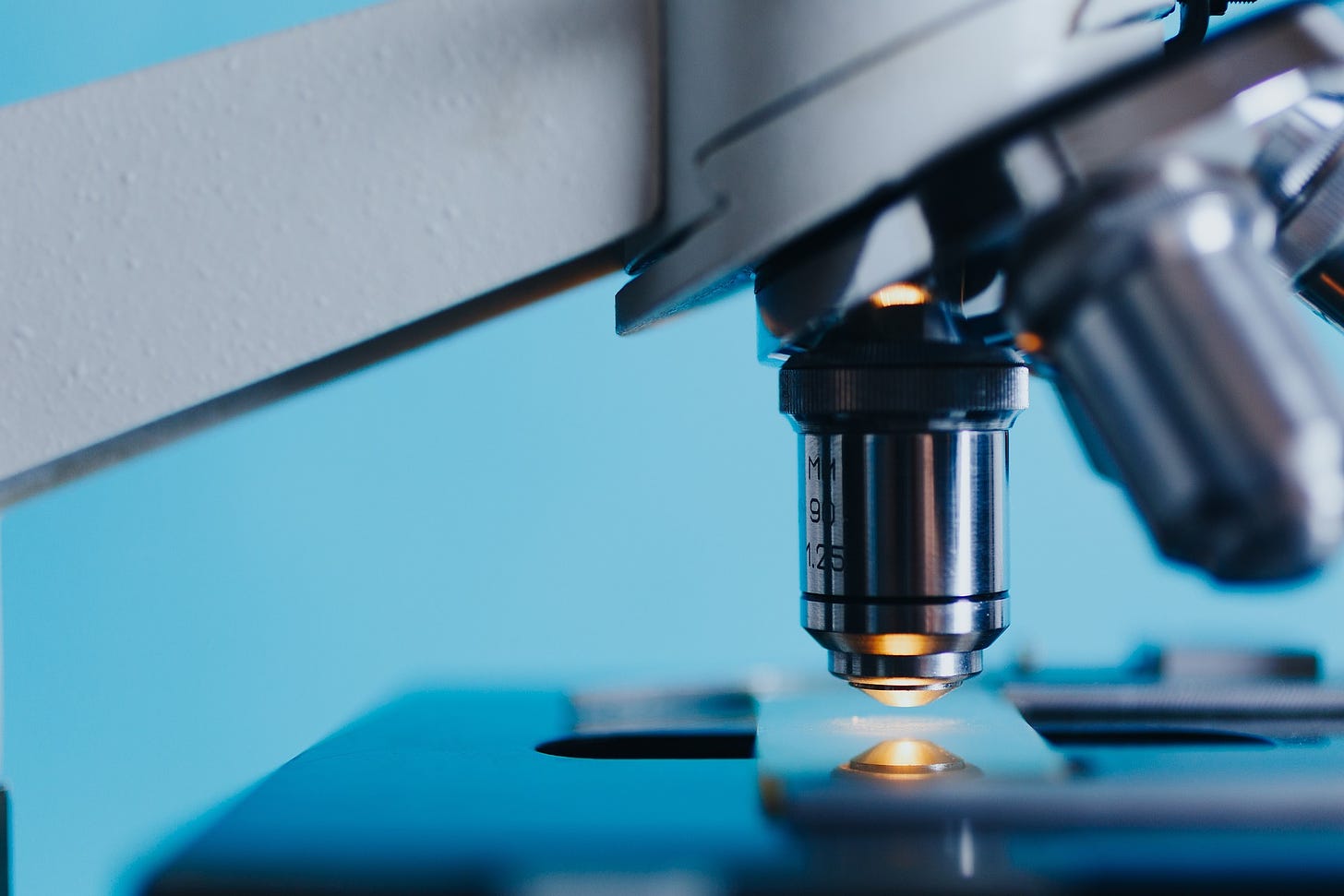
Update – 18 September 2023
The order of the sections of this article has been rearranged to introduce the most important information first. As mentioned in my most recent article titled: Hacking at the Root of the Virus Issue it was explained that for the longest time I thought that failure to “isolate” viruses was the most important evidence to focus on. This is however not the case as explained in detail in the “Hacking at the Root of the Virus Issue” article.
Transmission is the fundamental assumption on which virology rest. Without proof of transmission, nothing downstream matters. Even though understanding these downstream concepts will never be a waste of time one must consider that the normal man on the street will not be interested in complicated terminology and processes.
It is of crucial importance for the no virus community to find easier ways to explain the fallacy that is virology. Seeing as no one need a laboratory to assess whether transmission is possible and because we can observe this phenomena ourselves (Inductive reasoning) this is the linchpin for virology. A twitter space where we discussed this can be viewed here (*Note: Jamie was cut off during his talk and his section was not included).
As discussed during the twitter space, we have reviewed the available transmission studies and a summary of these studies can be seen below.
Transmission / Infection
One of the funniest things you will see while debating the trolls on Twitter is that they will provide studies conducted to prove the efficacy of vaccines. The people that undertake these studies assume that transmission or infection has already been proven, but nothing could be further from the truth. That is why it is important for us to list the peer-reviewed studies that disprove transmission or infection to further demonstrate that virology is a pseudoscience. The list of studies was compiled with the help of Jamie, georgie&donny, and Aldhissla (also see Aldhissla’s list on polio here).
(*Please note that this section is open to comments at the moment and anyone that want to add notes or studies are free to leave a comment).
- The Journal of Infectious Diseases, Vol. 2, No. 2 (Mar. 1, 1905):
– Chapman, 1801: Tried to transmit measles using the blood, tears, the mucus of the nostrils and bronchia, and the eruptive matter in the cuticle without any success.
– Willan, 1809: Inoculated three children with vesicle fluids of measles but without success.
– Albers, 1834: Attempted to infect four children with measles without success. He quoted Alexander Monro, Bourgois, and Spray as also having made unsuccessful inoculations with saliva, tears, and cutaneous scales.
– Themmen, 1817: Tried to infect 5 children with measles. 0/5 children became sick. - Charles Creighton, 1837 (A history of epidemics in Britain). “No proof of the existence of any contagious principles by which it was propagated from one individual to another.”
- EH Ackernecht, writing about Anticontagionism between 1821 and 1867 – “That the anticontagionists were usually honest men and in deadly earnest is shown, among other things, by the numerous self-experiments to which they submitted themselves to prove their contentions.” also see “Famous are the plague self-experiments of Clot-Bey, the offers for plague self-experiment by Chervin, Lassis, Costa, Lapis, and Lasserre, and the cholera self-experiments of Fay, Scipio Pinel, Wayrot, and J.L. Guyon. The amazing thing is that almost all of these experiments failed to produce the disease.”
- Note on Hospitals by Florence Nightingale, 1858 – “Suffice it to say, that in the ordinary sense of the word, there is no proof, such as would be admitted in any scientific inquiry, that there is any such thing as ‘contagion.” also see “Just as there is no such thing as ‘contagion,’ there is no such thing as inevitable ‘infection.”
- Andreas Christian Bull, 1868 – “It does not seem apparent in this small [polio] epidemic that contagion played any role, because the disease occurred here and there in the different places of the district without the possibility of establishing any relation between the various cases or the families of the same.”Karl-Oskar Medin, 1887 – A Swedish pediatrician who was the first to examine a polio outbreak, concluded that it was an infectious, but not contagious, disease.
- Charles Caverly, 1894 – Investigated the first US polio epidemic: ”it is very certain that it was non-contagious.”
- Journal of American Medical Association, Volume 72, Number 3, 1919 (or additional link here):- Warschawsky, 1895 – Injected small pigs and rabbits with blood taken in the eruptive stage. All results were negative.
– Belila, 1896 – Placed warm nasal mucus and saliva from measles patients on the nasal and oral mucous membrane of rabbits, guinea-pigs, cats, mice, dogs and lambs, but without any positive results.
– Josias, 1898 – Rubbed measles secretions over the throat, nose and eyes of several young pigs, but without any effects.
– Geissler, 1903 – Inoculated sheep, swine, goats, dogs and cats in various ways with the bodily fluids from patients with measles; including smearing, spraying, rubbing. All results were negative.
– Pomjalowsky, 1914 – Injected measles blood into guineapigs, rabbits and small pigs. All results were negative.
– Jurgelunas, 1914 – Inoculated blood from patients with measles into suckling pigs and rabbits, but without effect. - Leegaard, 1899 – Was not able to prove a single case of patient-to-patient contagion in a polio outbreak in Norway. “Infantile paralysis is of an infectious, but not of a contagious nature. As a matter of fact no indisputable instance of contagion could be proved.”
- Dr. Rodermund, 1901 – From his diary of SmallPox experiments. For 15 years he smeared the pus of smallpox patients on his face and used to go home with his family, play cards at the gentleman’s club and treat other patients and never got sick or saw a single other person get sick.
- Walter Reed, 1902 – “Without entering into details, I may say that, in the first place, the Commission saw, with some surprise, what had so often been noted in the literature, that patients in all stages of yellow fever could be cared for by non-immune nurses without danger of contracting the disease. The non-contagious character of yellow fever was, therefore, hardly to be questioned.”
- The New York Neurological Society, 1907 – “A Collective Investigation Committee of the New York Neurological Society…was appointed to investigate this epidemic of 1907 … The committee concluded from the returned blanks that poliomyelitis was infectious but not a contagious disease.”
- Landsteiner & Popper, 1909 – “Attempts to transmit the disease [polio] to the usual laboratory animals, such as rabbits, guinea pigs, or mice, failed.”
- F.E. Batten, (1909) – “Against the infectivity of the disease may be urged, first, the absence of spread of infection in hospital. The cases of poliomyelitis admitted to hospital freely mixed with other cases in the ward without any isolation or disinfection, some 70 children came in contact, but no infection took place. (p. 208, last paragraph)”
- The Boston medical and surgical journal, 1909 – An inquiry a 1908 polio outbreak found the following: “A large number of children were in intimate contact with those that were sick, and of these children an insignificant minority developed the disease.” 244 children were in intimate contact with those who were afflicted with polio. Of those 244 children, an “insignificant minority” developed the disease.
- Massachusetts State board of health, 1909 – “Poliomyelitis prevailed in epidemic form in Kansas during the summer of 1909 … No method of contagion could be found, and the author does not consider the disease contagious.”
- Flexner & Lewis, 1910 – Multiple unsuccessful polio transmission attempts. “Many guinea-pigs and rabbits, one horse, two calves, three goats, three pigs, three sheep, six rats, six mice, six dogs, and four cats have had active virus introduced in the brain but without causing any appreciable effect whatever. These animals have been under observation for many weeks.”
- A Washinton, 1911 – “I have not seen any cases of Polio contagion. We put the patients on one side and typhoid cases on the other, and no nurse or mother was infected. If the disease was so contagious, I don’t see why the nurses and mothers would not have been infected.”
- J.J. Moren, 1912 – “Monkeys suffering from polio in the same cage with healthy monkeys, do not infect others.”
- P. H. Römer, 1913 – “No proofs of the contagiousness of the disease [polio] could be obtained in the great epidemic in New York in 1907, nor in the epidemic in the Steiermark (Furntratt, Potpeschnigg) nor in Pomerania (Peiper).
- H. W. Frauenthal, 1914 – “Advocates of the contagion theory were at a loss to account for the fact that spontaneous [polio] transmission among laboratory monkeys was never known to occur … There is no proof that spontaneous transmission of acute poliomyelitis, without an inoculation wound, can take place. There is no proof that contact contagion takes place. Spontaneous development of the disease among laboratory animals is unknown.”
- W.H. Frost, 1916 – “The disease [polio] develops in a such a small proportion of people known to have been intimately associated with acute cases of polio.” … “The majority of cases of poliomyelitis can not be traced to known contact, either direct or indirect, with any previous case.”
- W. L. Holt, 1916 – Investigated an epidemic of polio and found that he was “surprised that I could trace hardly any cases to personal contact with others, there rarely being successive cases.”
- Dr. I. D. Rawlings, 1916 – “Any one who has had much experience with poliomyelitis is struck by the infrequency, relatively, of the secondary cases among direct contacts … there were approximately 1,500 direct contacts, and yet but one possible case occurred among them. Also among the large number of people that came from New York and other infected areas not a single case occurred.”
- H. L. Abramson, 1917 – Attempts to induce polio in a monkey by injecting the spinal fluid of 40 polio patients (rather than the ground cord) into the brain failed.
- Dold et al. 1917 (Original paper in German from Muenchener Medizinische Wochenschrift 64 ( 1917), bottom of p 143) – Injected healthy people with the nasal secretions taken from one ill person, 1/40 healthy people became ill.
- A review of the investigations concerning the etiology of measels, A. W. Sellards
harvard Medical School. Boston, Massachusetts as seen below:
– Jurgelunas, 1914: Tried to produce measles in monkeys using inoculations of the blood and mucus secretions from measles patients as well as by exposing the animals to patients in measles wards. All results were negative.
– Sellards, 1918: Tried to transmit measles to 8 healthy volunteers without a prior history of measles exposure. 0/8 men became sick after multiple failed attempts.
– Sellards and Wenworth, 1918: Inoculated 3 monkeys in various ways, including intensive injections of blood from measles patients. The animals remained well.
– Sellards and Wenworth, 1918: Blood from measles patients was injected simultaneously into 2 men and 2 monkeys. Both men remained symptom-free. One of the two monkeys developed symptoms that were not suggestive of measles. - Milton Rosenau, 1918 – Professor of preventive medicine and hygiene at Harvard, notes that “monkeys have so far never been known to contract the disease [polio] spontaneously, even though they are kept in intimate association with infected monkeys.” Page 341.
- Hess & Unger, 1918 – “In three instances the nasal secretion of varicella patients was applied to the nostrils; in three others the tonsillar secretion to the tonsils, and in six, the tonsillar and pharyngeal secretions were transferred to the nose, the pharynx, and the tonsils. In none of these twelve cases was there any reaction whatsoever, either local or systemic.”
- Hess & Unger, 1918 – The vesicle fluids from people with chickenpox was injected intravenously into 38 children. 0/38 became sick.
- Published in the Journal – American Medical Association, 1919 – Need Of Further Research On The Transmissibility Of Measles And Varicella. “Evidently in our experiments we do not, as we believe, pursue nature’s mode of transmission; either we fail to carry over the virus, or the path of infection is quite different from what it is commonly thought to be.”
- Milton J. Rosenau, March 1919 – Conducted 9 separate experiments in a group of 49 healthy men, to prove contagion. In all 9 experiments, 0/49 men became sick after being exposed to sick people or the bodily fluids of sick people. More information on the Rosenau studies here.
- Wahl et al, 1919 – Conducted 3 separate trials on six men attempting to infect them with different strains of Influenza. Not a single person got sick.
- Schmidt et al, 1920 (Original paper in German here) – Conducted two controlled experiments, exposing healthy people to the bodily fluids of sick people. Of 196 people exposed to the mucous secretions of sick people, 21 (10.7%) developed colds and three developed grippe (1.5%). In the second group, of the 84 healthy people exposed to mucous secretions of sick people, five developed grippe (5.9%) and four colds (4.7%). Of forty-three controls who had been inoculated with sterile physiological salt solutions eight (18.6%) developed colds. A higher percentage of people got sick after being exposed to saline compared to those being exposed to the “virus”.
- Williams et al, 1921 – Tried to experimentally infect 45 healthy men with the common cold and influenza, by exposing them to mucous secretions from sick people. 0/45 became ill.
- Mahatma Gandhi, 1921 – “and the poison that accumulates in the system is expelled in the form of small-pox. If this view is correct, then there is absolutely no need to be afraid of small-pox” also see “This has given rise to the superstition that it is a contagious disease, and hence to the attempt to mislead the people into the belief that vaccination is an effective means of preventing it.”
- Blanc and Caminopetros, 1922 (original paper in French here) – Material from nine cases of shingles was inoculated into the eyes, cornea, conjunctiva, skin, brain, and spinal cord of a series of animals, including rabbits, mice, sheep, pigeons, monkeys, and a dog. All results were negative.
- Robertson & Groves, 1924 – Exposed 100 healthy individuals to the bodily secretions from 16 different people suffering from influenza. 0 people of 100 whom they deliberately tried to infect with Influenza got sick That is because Viruses don’t cause disease.
- Bauguess, 1924 – “A careful search of the literature does not reveal a case in which the blood from a patient having measles was injected into the blood stream of another person and produced measles.”
- The problem of the etiology of herpes zoster, 1925 – “Many other authors report entirely negative results following the inoculation of herpes zoster material into the sacrified corneas of rabbits: Kraupa (18); Baum (19); LSwenstein (8), Teissier, Gastinel, and Reilly (20) ; Kooy (21) ; Netter and Urbain (22); Bloch and Terris (23); Simon and Scott (24); and Doerr (25). It is evident, therefore, that the results of attempts to inoculate animals with material from cases of herpes zoster must be considered at present to be inconclusive.”
- Volney S and Chney M.D., 1928 – A study where it is clearly stated that cold is not infectious.
- Dochez et al, 1930 – Attempted to infect 11 men with intranasal influenza. Not a single person got sick. Most strikingly one person got very sick when he accidently found out that is what they were trying to do. His symptoms disappeared when they told him he was misinformed.
- L. L. Lumsden, 1935 – “Painstaking efforts were made throughout the studies to obtain all traces of transmission of the disease through personal contact, but it appears that in this outbreak in Louisville evidence of personal association between the cases of poliomyelitis, suggestive of cause and effect, was no more common than that which might have been found if histories had been taken of personal association between cases of broken bones occurring in the city in the same period.”
- Thomas Francis Jr et al, 1936 – Gave 23 people influenza via 3 different methods. 0 people got sick.. They gave 2 people already “suffering from colds” the influenza who also did not get sick
- Burnet and Lush, 1937 – 200 people given “Melbourne type” Influenza . 0 people showed any symptoms of disease. 200/0.
- Lumsden, 1938 – “It is quite usual in small [polio] outbreaks in rural counties for individual cases to develop in separate homes three or for miles apart without there being any evidence of direct or indirect personal contact having operated between persons afflicted.”
- L. L Lumsden, 1938 – ”The general and usual epidemiological features of the disease [polio] all appear opposed to the hypothesis that poliomyelitis is a contagious disease spread among human beings by nose-to-nose or any other direct personal contact.”
- Burnet and Foley, 1940 – Attempted to experimentally infect 15 university students with influenza. The authors concluded their experiment was a failure.
- Thomas Francis Jr, 1940 – Gave 11 people “Epidemic Influenza” 0 people got sick. That is because viruses don’t cause disease.
- John Toomey, 1941 – A veteran polio researcher: “no animal gets the disease from another, no matter how intimately exposed.”
- A. R. Kendall, 1945 – “The epidemiological facts of poliomyelitis are these: … (2) A majority of cases of clinically diagnosable poliomyelitis (polioparalysis) occur sporadically, with no history of contact with previous cases. (3) Two cases of polioparalysis in one family are unusual, even though no precautions are taken to prevent cross infection. (4) Clinically diagnosable cases of poliomyelitis (polioparalysis) show little tendency to spread, even in schools or other places of public gathering. (5) Incidence of polioparalysis is no greater among doctors and nurses, in intimate contact with acute cases than it is among the civil population, even though the former are exposed freely to infection.” […] “Polioparalysis is not contagious.”
- E. B. Shaw & H. E. Thelander, 1949 – “The epidemiology of the disease [polio] remains obscure. There has been a tendency to depart from an early theory that the disease spreads by means of direct contact.”
- Albert Sabin, 1951 (inventor of the polio vaccine). “There is no evidence for the transmission of poliomyelitis by droplet nuclei.”
- Archibald L. Hoyne, 1951 (alternative link here) – “However, in the Cook County Contagious Disease Hospital where the latter procedure has not been used there has never been a doctor, intern, nurse or any other member of the personnel who contracted poliomyelitis within a period of at least thirty-five years, nor has any patient ever developed poliomyelitis after admission to the hospital.”
- Ralph R. Scobey, 1951 – ”Although poliomyelitis is legally a contagious disease, which implies that it is caused by a germ or virus, every attempt has failed conclusively to prove this mandatory requirement of the public health law.” Professor of clinical pediatrics and president of the Poliomyelitis Research Institute, Syracuse, N.Y.
- Ralph R. Scobey, 1952 – “In addition to the failure to prove contagiousness of human poliomyelitis, it has likewise been impossible to prove contagiousness of poliomyelitis in experimental animals.”
- Douglas Gordon et al, 1975 – This study gave 10 people English type Influenza and 10 people a placebo. The study was negative. Most telling is they admit that mild symptoms were seen in the placebo group, proving that the inoculation methods cause them.
- Beare et al 1980 (refer to reference 6 in the linked paper). Quote from John J Cannell, 2008 as follows – “An eighth conundrum – one not addressed by Hope-Simpson – is the surprising percentage of seronegative volunteers who either escape infection or develop only minor illness after being experimentally inoculated with a novel influenza virus.”
- Nancy Padian, 1996 – A study which followed 176 discordant couples (1 HIV positive and the other negative) for 10 years. These couples regularly slept together and had unprotected sex. There were no HIV transmissions from the positive partner to the negative partner during the entirety of the study.
- John Treanor et al, 1999 – Gave 108 people Influenza A. Only 35% recorded mild symptoms such as stuffy nose. Unfortunately 35% of the placebo control group also developed mild symptoms proving the methods of inoculation are causing them.
- Bridges et al, 2003 – “Our review found no human experimental studies published in the English-language literature delineating person-to-person transmission of influenza… Thus, most information on human-to-human transmission of influenza comes from studies of human inoculation with influenza virus and observational studies.”
- The Virology Journal, 2008 – ”There were five attempts to demonstrate sick-to-well influenza transmission in the desperate days following the pandemic [1918 flu] and all were ’singularly fruitless’ … all five studies failed to support sick-to-well transmission, in spite of having numerous acutely ill influenza patients, in various stages of their illness, carefully cough, spit, and breathe on a combined total of >150 well patients.”
- Public Health Reports, 2010 – ”It seemed that what was acknowledged to be one of the most contagious of communicable diseases [1918 flu] could not be transferred under experimental conditions.”
- T.C. Sutton et al, 2014 – “Throughout all ferret studies, we did not observe an increase in sneezing, and a febrile response (i.e., elevation of body temperature) was inconsistent and was not a prominent feature of infection.”
- Jasmin S Kutter, 2018, – Our observations underscore the urgent need for new knowledge on respiratory virus transmission routes and the implementation of this knowledge in infection control guidelines to advance intervention strategies for currently circulating and newly emerging viruses and to improve public health.
– There is a substantial lack of (experimental) evidence on the transmission routes of PIV (types 1–4) and HMPV.
– Extensive human rhinovirus transmission experiments have not led to a widely accepted view on the transmission route [35, 36, 37, 38, 39, 40].
– However, until today, results on the relative importance of droplet and aerosol transmission of influenza viruses stay inconclusive and hence, there are many reviews intensively discussing this issue [10, 45, 46, 47, 48, 49, 50].
– Despite this, the relative importance of transmission routes of respiratory viruses is still unclear, depending on the heterogeneity of many factors like the environment (e.g. temperature and humidity), pathogen and host [5, 19]. - Jonathan Van Tam, 2020 – Conducted these human trials of Flu A in 2013. 52 people were intentionally given “Flu A” and made to live in controlled conditions with 75 people. 0 people sick. 0 PCR positive.
- J.S. Kutter, 2021 – “Besides nasal discharge, no other signs of illness were observed in the A/H1N1 virus-positive donor and indirect recipient animals.” The animals were subsequently euthanized after the animals experienced what the scientist describe as having breathing difficulties (no further details were given to describe their condition). *Refer to Note 1.
- Ben Killingley, 2022 – Gave 36 people what he considered to be purified Covid Virus Intranasally. The Results: Nobody got sick. *Refer to Note 2.
Notes
*Note 1 – Jasmin Kutter, 2021:
- From the Results section: “Throat and nasal swabs were collected from the donor and indirect recipient animals on alternating days.” This on its own can lead to nasal discharge which is the only “sign of illness” that was noted in this study.
*Note 2 – Ben Killingley, 2022:
- See the video explanation by Jamie here.
- Ben Killingley also conducted a study in the early 2010’s in which he had inoculated people in a room with 75 others some wearing masks others as a control. Not a single person even tested PCR positive. Some links to his previous studies include a 2011, 2019 and a 2020 study.It is assumed that his latest, 2022 study, is a follow up to cover the findings of his previous findings. Some additional notes on the study referenced include:– They gave 10 people the potent nephrotoxin Remdisivir.– They measure sickness by means of a PCR test which isn’t indicative of disease because it can tests positive with “asymptomatic” cases as well.– Even if you say that a runny nose after swabbing is Covid. A 50% outcome to a direct challenge of something is a negative result. It doesn’t suggest causation which would need to be at least 90%.– The very methods of inoculation used during the study could cause the nasal congestion/discharge (which is their measure of whether someone is sick or not). This has been shown in previous studies.– Lastly nobody was given “regeneron” because nobody got “sick”.
*Note 3 – Dr Robert Willner, 1994:
- December 7th 1994 Hollywood Roosevelt Hotel, Greensboro, N.C., Dr Willner (a medical doctor of 40 years experience) an outspoken whistleblower of the AIDS hoax. In front of a gathering of about 30 alternative-medicine practitioners and several journalists, Willner stuck a needle in the finger of Andres, 27, a Fort Lauderdale student who says he has tested positive for HIV. Then, wincing, the 65-year-old doctor stuck himself. In 1993, Dr. Willner stunned Spain by inoculating himself with the blood of Pedro Tocino, an HIV positive hemophiliac. This demonstration of devotion to the truth and the Hippocratic Oath he took, nearly 40 years before, was reported on the front page of every major newspaper in Spain. His appearance on Spain’s most popular television show envoked a 4 to 1 response by the viewing audience in favor of his position against the “AIDS hypothesis.” When asked why he would put his life on the line to make a point, Dr. Willner replied: “I do this to put a stop to the greatest murderous fraud in medical history. By injecting myself with HIV positive blood, I am proving the point as Dr. Walter Reed did to prove the truth about yellow fever. In this way it is my hope to expose the truth about HIV in the interest of all mankind.” He tested negative multiple times. He died of a Heart attack 4 months later 15th April 1995 (yeh right, funny how these naysayers all die suddenly. Link to the presentation here.
*Note 4 – Dr Thomas Powell, 1897:
- Deadly Germs. How Dr. Thos. Powell has Swallowed Them. Bacilli in his system. He laughs at the theory of contagion. Gives to the world the story of his ten years’ defiance of the death-dealing Bacilli.Men have done strange things and taken desperate chances in the Interests of science. But none has been stranger or more desperate that the act of Dr. Thomas Powell, a physician who about a year ago took up his residence in this city, and who has actually taken into his system during the last ten years the germs of the deadliest diseases, for the specific purpose of shattering the time-honored theories regarding the transmission of contagious complaint* from one person to another.Incredible as it may seen, Dr. Powell has not only survived the desperate experiments that he has undertaken, but has never shown the slightest signs of any ill effects resulting from them. The evidence regarding the truth of his claim is conclusive. His own written statements are backed up by the testimony of well-known physicians in whose presence Dr. Powell has taken the germs into his system during experiments that he has been secretly making during the past ten years.
- If you ask the Germ theorist to point out the relation between injecting germs into small animals and giving humans the same germs in food or drink, they have to admit that these arc two distinct procedures with practically no relationship.If you ask why thousands of men carry germs without injury to themselves the replies vary, but all are unsatisfactory.If you examine the standard works on bacteriology you find no positive proofs given, that germs, if taken in food or drink, are harmful.
Ludicrous “Transmission” Studies
The picture of virology’s ludicrousy won’t be complete without a list of studies showing the insanity of what virologists claim to be transmission of disease. This include the injection of fluids into the brains and lungs of animals and we may just include some epidemiological studies to show how these are also not proof of anything. Joe Hendry mostly put it together and the papers we have are as follows (*Please note that this section is open to comments at the moment and anyone that want to add notes or studies are free to leave a comment):
- Louis Pasteur, 1881 – For rabies, tried to demonstrate transmission by injecting diseased brain tissue “directly onto the surface of the brain of a healthy dog through a hole drilled into its skull.”
- Simon Flexner and Paul A. Lewis, 1910 – Spinal cords from deceased children were ground up and emulsified to be injected into the brains of monkeys. Study explained in detail here.
- John F. Anderson and Joseph Goldberger, 1911 – Injected blood from a measles patient directly into the heart and brains of monkeys.
- Carl Tenbroeck, 1918 – A mixture of ground up rat’s livers, spleens, kidneys,
testicles, lungs, hearts, and brains was injected into the brains of other rats. - T.M. Rivers et al, 1929 – “The serum to be tested, from J., was mixed with an equal amount of virus, and then 0.25 cc. of the mixture was injected into each testicle of Monkey” and “The results of the above experiment indicated to us that the serum from an individual who had had varicella many years previously did not contain sufficient antibodies to prevent the appearance of inclusions in testicles inoculated with chicken-pox virus”
- Claus W. Jungeblut, 1931 – Ground up monkey spinal cord was injected into the brains of other monkeys.
- Wilson Smith, 1933 – “The infected animal is killed when showing symptoms, often at the beginning of the second temperature rise. The turbinates are scraped out, ground up with sand, and emulsified in about 20 c.cm. of equal parts of broth and saline. The emulsion is lightly centrifuged, and about 1 c.cm. of the supernatant fluid is dropped into the nostrils of another ferret.”
- Thomas Francis and Jr, T. P. Magill, 1935 – Ground up ferret lung tissue was injected into the brains of rabbits.
- Ann G. Kuttner and T’sun T’ung, 1935 – Ground up kidney and brain of a guinea pig was injected into the brain of another guinea pig.
- Erich Traub. April 01 1936 – Ground up mouse brain was injected into the brains of guinea pigs.
- Albert B. Sabin and Peter K. Olitsky, 1937 – Ground up mouse brain was injected into the brains of other mice.
- G. John Buddingh, 1938 – Ground up chick embryo was injected into the brains 2 or 3 day old chicks.
- Gilbert Dalldorf, 1939 – Ground up ferret spleens was injected into the brains of mice.
- Claus W. Jungeblut et al, 1942 – Ground up brain or spinal cord of paralyzed mice was injected into the brains of 13 monkeys.
- Henry Pinkerton and Vicente Moragues, 1942 – Ground up brain tissue from dying mice was injected into the brains of pigeons.
- C. Kling et al, 1942 – Injected sewage sludge into the brains and abdomen of monkeys. This convinced him that he had isolated a virus and proven that the sewer is a vehicle for polio transmission.
- D.M. Horstmann, 1944 – Allegedly “proved” that the feces of polio patients contained “poliovirus” by injecting fecal samples into monkeys’ brains and spines.
- Joseph E. Smadel et al, 1945 – Ground up pigeon spleen was injected into the brains of mice.
- F. Sargent Cheever et al, 1949 – Ground up mouse brain was injected into the brains of rats and hamsters.
Isolation
Isolation has been well defined in Virus Lie – The Result of 4 Years of Study and to this day there has not been a single paper presented that could show the isolation of a virus without first contaminating the sample. This is shown in detail in the virus lie article and will not be repeated here again. One interesting point that can be captured here is all the studies showing a control test proving that the isolation method used for viruses is flawed. They can be listed as follows:
- John F Enders, 1954 – Under other agents isolated during the study. “A second agent was obtained from an uninoculated culture of monkey kidney cells. The cytopathic changes it induced in the unstained preparations could not be distinguished with confidence from the viruses isolated from measles.” It is highlighted here. Refer to the video explanation here.
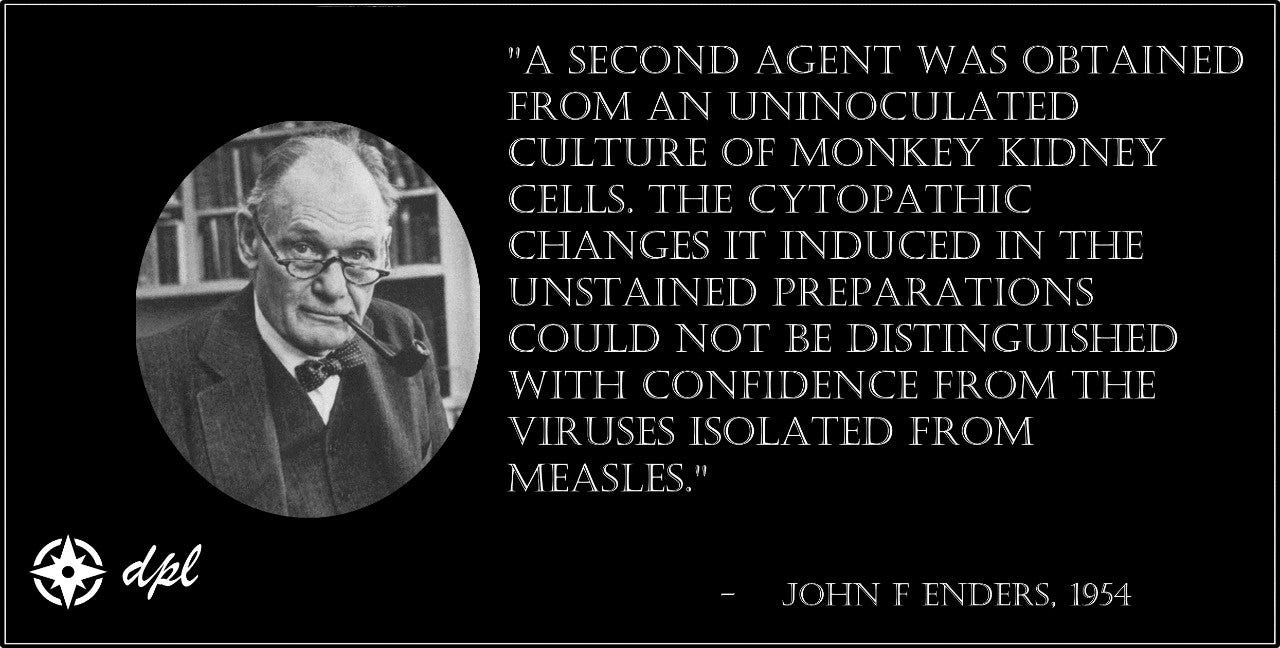
- It is further discussed in the paper that “While there is no ground for concluding that the factors in vivo (in the body) are the same as those which underlie the formation of giant cells and the nuclear disturbances in vitro (outside a living organism), the appearance of these phenomena in cultured cells is consistent with the properties that a priori might be associated with the virus of measles.”
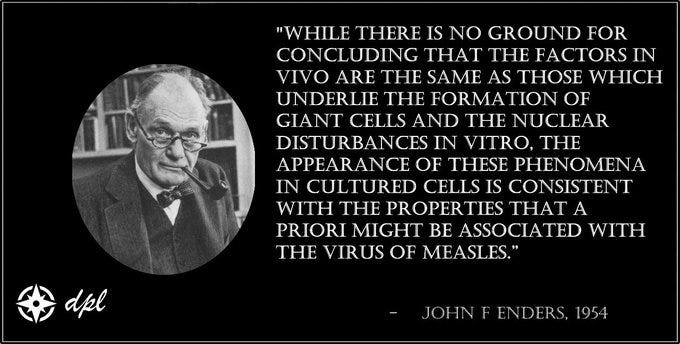
- Rustigian et al, 1955 – This paper is described in an article by Viroliegy here (look under Rustigain in the article).
- Cohen et al, 1955 – This paper is also described in the same article by Viroliegy here (look under Cohen in the article).
- Bech and von Magnus, 1959 – This paper is also described in the same article by Viroliegy here (look under Von Magnus in the article).
- F Rapp et al, 1959 – This paper is described in a video by Spacebusters here. Most noteworthy is “Monkey kidney cells, however, are unsuitable for the investigations of the type reported here; Peebles et al. and Ruckle showed that monkeys, and cell cultures derived from them, are often infected with an agent serologically indistinguishable from human measles virus, which causes cytopathic changes in monkey kidney cell cultures almost identical with those caused by human measles virus.”
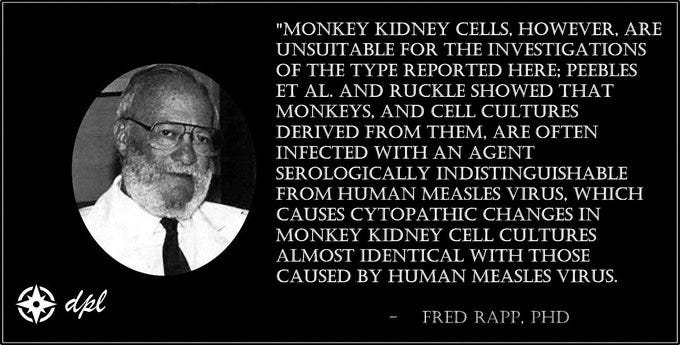
- Carl J. O’Hara et al, 1988 – The study demonstrated “HIV” particles in 18 out of 20 (90% of) AIDS-related lymph node enlargements but also in 13 out of 15 (88% of) non-AIDS-related enlargements. Which means that particles claimed to be HIV virions are non-specific since identical particles can be found in the majority of patients with enlarged lymph nodes not attributed to AIDS, and at no risk for developing AIDS. Refer to @Aldhissla45’s tweet here.
- P Gluschankof et al, 1997 – This paper described in a video here with additional notes by Jamie here.
- Julian W. Bess Jr., 1997 – This paper described in a video here with additional notes by Jamie here.
- C.A. Cassol, 2020 – This paper is described by Andrew Kaufman here as well as by Thomas Cowan here.
“Unofficially” we can also add the Lanka 3 phase control experiment that can be seen here or searched for it here.
A further indication of the isolation procedure fallacy is shown in a study during which the CPE becomes more well defined with the addition of specific substances. The study is as follows:
- Leon Caly et al, 2020 – “Following several failures to recover virions with the characteristic fringes of surface spike proteins, it was found that adding trypsin to the cell culture medium immediately improved virion morphology.” See a video explanation here.
Recent Requests and Statements
Further and more recent requests and statements that were sent to me by my good friend Courtenay are as follows:
- February 22, 2021:Contagion A Fairy Story – Where is the evidence that viruses cause disease? I have been asking for almost 12 months now, and no one has been able to provide me with a single peer reviewed journal article showing an isolated virus causes disease. It should be so easy to look through the literature and find a study in a couple of minutes, yet no one seems to be able to do such a thing. Scientists and doctors have already done countless experiments to try and prove germ theory over the course of 120+ years, and all have failed.
- May 5, 2022:
U.S. CDC and Agency for Toxic Substances and Disease Registry confirmed that a search of their records failed to find any that describe anyone on Earth finding an alleged “avian influenza virus” in the bodily fluids of any diseased diseased host (animal or human) and purifying “it”… which is necessary so that “it” could be sequenced, characterized and studied with controlled experiments. This can be viewed here. - May 20, 2022:
Public Health Agency of Canada confirmed that they have no record of any alleged “avian influenza virus” having been found and purified from the bodily fluid/tissue/excrement of any diseased “host” on the planet (in order for “it” to be sequenced, characterized and studied with controlled experiments) by anyone, anywhere, ever.
Insanely, they insist that:- “Viruses” are in hosts despite their utter inability to find them there,.It’s necessary to “grow them” in non-host cells (as if “they” would grow better there than they allegedly grew in the diseased host lol).They pretend that mixing complex substances together results in purification.
- December 20, 2021:
Public Health Agency of Canada confirmed that they have no record of any alleged “virus” having been purified from a sample taken from any diseased human on Earth, by anyone, ever, period. To be viewed here. - March 11, 2022:
U.S. Centers for Disease Control and Prevention and Agency for Toxic Substances and Disease Registry respond to a FOIA request for all studies / reports in their possession, custody or control describing the purification of any “virus” addressed by any “vaccine” on either their childhood or adult U.S. “immunization” schedule, directly from a sample taken from any diseased “host” on Earth where the sample was not first combined with any other source of genetic material. CDC/ATSDR provided 5 studies on “rotavirus” (thereby admitting they have no records for any other alleged viruses). None of these 5 studies actually describe isolation/purification of a “rotavirus” from a human.
Request, response, studies to be viewed here. - March 8, 2023:
Italy 2020: Inside Covid’s “Ground zero” in Europe – Three years ago the Western World came to a standstill. The official Covid-19 narrative depicted a strange suddenly-super-spreading, deadlier-than-flu virus hailing from China that landed in Northern Italy.On February 20, 2020 the first alleged case of Covid-19 was discovered in the West in the Lombardy town of Codogno, Italy. Later that day the Italian government reported their first “Covid-19 death.”Dramatic media reports emerging from Northern Italy were hammered into and onto the Western psyche giving the impression there was a mysterious “super spreading” and “super lethal” novel virus galloping across the region infecting and killing scores of people.Read the rest of the report here.
Conclusion
The above list will be worked on over the coming years. If you think that any corrections need to be made or if you want to add additional studies, please leave a comment.

Source: Virology – The Damning Evidence
Other places to find me:
